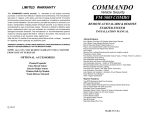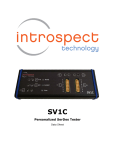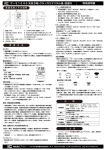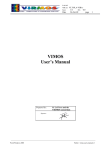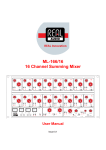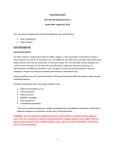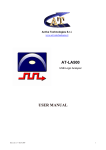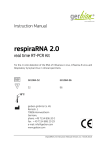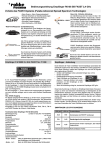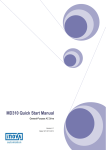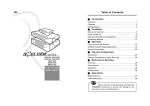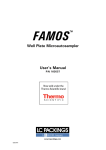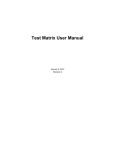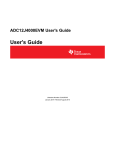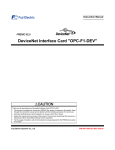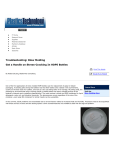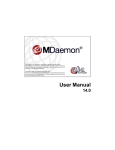Download Datasheet
Transcript
SV V1C C Perso onalize ed SerD Des Tes ster Da ata Sheet SV V1C Pe ersonalized Se erDes Tester T Datta Shee et Rev vision: 1.4 4 201 14-04-15 5 Revisio on Revisiion Historry Date e 1.0 Docume ent release Feb 27, 2 2013 1.1 Updated jitter injec ction specs, SSC specs,, clock dded block diagram d des scriptions recoverry specs; ad Oct 07, 0 2013 1.2 Minor edits e Oct 07, 0 2013 1.3 Update to specifica ations Nov 12, 1 2013 1.4 Update to specifica ations Apr 15, 1 2014 The inforrmation in th his documen nt is subject to change without w noticce and should d not be construed as a comm mitment by In ntrospect Teechnology. While W reason nable precau utions have been b ntrospect Tecchnology asssumes no ressponsibility for any erro ors that may appear in th his taken, In documen nt. No part of o this docum ment may bee reproduced d in any form m or by any means m witho out the priorr written consent c of In ntrospect Tecchnology. Product: SV1C Personalized d SerDes Tester Status: Releassed ht: Copyrigh 2014 Introspect I T Technology ESD CAU UTION ESD (electrostatic discharge) d sen nsitive devicee. Electrostatiic charges as high h as 4000 V readilyy accumulatee on the huma an body and teest equipmen nt and can discharge withou ut detecttion. Permaneent damage may m occur on devices d subjeccted to high energy e electro ostatic discha arges. Therefo ore, proper ES SD precaution ns are recomm mended to avvoid performa ance degrad dation or losss of functionallity. Table of Contents Table of Contents Introduction ........................................................................................................................ 2 Overview ........................................................................................................................ 2 Key Benefits ................................................................................................................... 2 Applications ................................................................................................................... 3 Features ............................................................................................................................... 4 Multi-Lane Loopback .................................................................................................... 4 Multiple Source Jitter Injection .................................................................................... 4 Pre-Emphasis Generation ............................................................................................. 6 Programmable SSC Generation and Frequency Synthesis ........................................... 7 Per-Lane Clock Recovery and Unique Dual-Path Architecture .................................... 7 Auxiliary Control Port.................................................................................................... 8 Analysis .......................................................................................................................... 9 Automation .................................................................................................................. 10 Specifications...................................................................................................................... 11 List of Figures Figure 1 Figure 2 Figure 3 Figure 4 Figure 5 Figure 6 Figure 7 Figure 8 Figure 9 Figure 10 Illustration of loopback applications.................................................................. 4 Illustration of calibrated jitter waveform. ......................................................... 5 Illustration of jitter tolerance curve. .................................................................. 5 Illustration of pre-emphasis design. .................................................................. 6 Illustration of multiple waveform shapes that can be synthesized using the pre-emphasis function of the SV1C............................................................... 6 Programmable SSC generation. ......................................................................... 7 Per-lane clock recovery and dual-path architecture. ......................................... 8 Photograph of the auxiliary control port on the SV1C. ..................................... 8 Sampling of analysis and report windows. ........................................................ 9 Screen capture of Introspect ESP user environment..................................... 10 SV1C Introduction and Features List of Tables Table 1 Table 2 Table 3 Table 4 Table 5 Table 6 Table 7 Table 8 General Specifications......................................................................................... 11 Transmitter Characteristics ................................................................................ 11 Receiver Characteristics .....................................................................................13 Clocking Characteristics .................................................................................... 14 Pattern Handling Characteristics ...................................................................... 14 Measurement and Throughput Characteristics .................................................15 Instruction Sequence Cache .............................................................................. 16 DUT Control Capabilities ................................................................................... 17 Page 1 SV1C Introduction and Features Introduction Overview The SV1C Personalized SerDes Tester is an ultra-portable, highperformance instrument that creates a new category of tool for high-speed digital product engineering teams. It integrates multiple technologies in order to enable the self-contained test and measurement of complex SerDes interfaces such as PCI Express Gen 3, MIPI M-PHY, Thunderbolt, or USB3. Coupled with a seamless, easy-to-use development environment, this tool enables product engineers with widely varying skills to efficiently work with and develop SerDes verification algorithms. The SV1C fits in one hand and contains 8 independent stimulus generation ports, 8 independent capture and measurement ports and various clocking, synchronization and lane-expansion capabilities. It has been designed specifically to address the growing need of a parallel, system-oriented test methodology while offering worldclass signal-integrity features such as jitter injection and jitter measurement. With a small form factor, an extensive signal-integrity feature set, and an exceptionally powerful software development environment, the SV1C is not only suitable for signal-integrity verification engineers that perform traditional characterization tasks, but it is also ideal for FPGA developers and software developers who need rapid turnaround signal verification tools or hardware-software interoperability confirmation tools. The SV1C integrates state of the art functions such as digital data capture, bit error rate measurement, clock recovery, jitter decomposition and jitter generation. Key Benefits True parallel bit-error-rate measurement across 8 lanes Fully-synthesized integrated jitter injection on all lanes Fully-automated integrated jitter testing on all lanes Optimized pattern generator rise-time for receiver stress test applications Flexible pre-emphasis and equalization Flexible loopback support per lane Hardware clock recovery per lane State of the art programming environment based on the highly intuitive Python language Integrated device control through SPI, I2C, or JTAG Reconfigurable, protocol customization (on request) Page 2 SV1C Introduction and Features Applications Parallel PHY validation of serial bus standards such as: PCI Express (PCIe) UHS-2 MIPI M-PHY CPRI USB HDMI Thunderbolt XAUI JESD204B SATA Interface test of electrical/optical media such as: Backplane Cable CFP MSA, SFP MSA, SFP+ MSA Plug-and-play system-level validation such as: PCI Express DisplayPort sink/source MIPI M-PHY Timing verification: PLL transfer function measurement Clock recovery bandwidth verification Frequency ppm offset characterization Mixed-technology applications: High-speed ADC and DAC (JESD204) data capture and/or synthesis FPGA-based system development Channel and device emulation Clock-recovery triggering for external oscilloscope or BERT equipment Page 3 SV1C Introduction and Feattures Fe eatures s Lane Loo opback Multi-L Th he SV1C is the only bench h-top tool th hat offers insstrument-gra ade loo opback capab bility on all differential d l lanes. The lo oopback cap pability of th he SV1C inclu udes: Retiming off data for thee purpose off decoupling DUT receiveer performancce from DUT T transmitterr performancce Arbitrary jittter or voltag ge swing con ntrol on loop pback data Fig gure 1 showss two commo on loopback configuratio ons that can n be useed with the SV1C. S In thee first configu uration, a sin ngle DUT’s tra ansmitter and receiver ch hannels are connected to ogether thro ough thee SV1C. In th he second co onfiguration,, arbitrary pa attern testin ng can n be perform med on an en nd-to-end co ommunicatio ons link. Thee SV V1C is used to o pass data through t from m a traffic geenerator (succh as an end-point on o a real systtem board) to t the DUT while w stressin ng thee DUT receivver with jitteer, skew, or voltage v swin ng. (a) Fiigure 1 (b) I Illustratio on of loop pback applications. Multiple Source Jitter Injection I n The SV1C is cap pable of geneerating calibrrated jitter sttress on any data d on. Sinusoidal jitter injecction patttern and anyy output lanee configuratio is calibrated c in the time and d frequency domain d in order to genera ate hig gh-purity stim mulus signalss as shown in n Figure 2. Pa age 4 SV1C Introduction and Feattures Injected Jitter (ps) 60 40 20 0 20 40 60 10 Figure 2 30 5 50 70 Time (ns) 90 110 Illu ustration of o calibratted jitter waveform m. Th he jitter injecction featuree is typically exploited in order to perrform autom mated jitter tolerance t tessting as show wn in the exa ample in Fig gure 3. As is the case for other featurres in the SV V1C Perrsonalized SerDes S Testeer, jitter tolerrance testing g happens in n parrallel across all lanes. Fo or advanced applicationss, the SV1C also a inccludes RJ injjection and a third-sourcce arbitrary waveform jiitter syn nthesizer. Figure 3 I Illustratio on of jitterr toleranc ce curve. Pa age 5 SV1C Introduction and Features Pre-Emphasis Generation Conventionally offered as a separate instrument, per-lane preemphasis control is integrated on the 8-lane SV1C tester. The user can individually set the transmitter pre-emphasis using a built-in Tap structure. Pre-emphasis allows the user to optimize signal characteristics at the DUT input pins. Each transmitter in the SV1C implements a discrete-time linear equalizer as part of the driver circuit. An illustration of such equalizer is shown in Figure 4, and sample synthesized waveform shapes are shown in Figure 5. Figure 4 Illustration of pre-emphasis design. Figure 5 Illustration of multiple waveform shapes that can be synthesized using the pre-emphasis function of the SV1C. Page 6 SV1C Introduction and Feattures Progra ammable e SSC Ge eneration n and Fre equency Synthes sis Th he SV1C incorporates preecision frequ uency syntheesis technolo ogy tha at allows for the generatiion of programmable SS SC waveform ms at anyy data rate. The T SSC wavveforms are superimpossed on the patttern genera ator outputs,, and they co oexist with other jitter injection sourcces of the SV V1C. Thus, a truly t compleete jitter coccktail n be produceed for the most thorough h receiver va alidation. Fig gure can 6 illlustrates the SSC capab bility of the SV1C. S In the figure, the SV1C S is programmed p d to synthesiize four sligh htly different modulation n freequencies showcasing the precision programmab p bility of the tool. t Figure 6 Program mmable SSC S generation. Per-La ane Clock k Recove ery and Unique U D Dual-Path h Archite ecture Lik ke pre-emph hasis, conven ntional tools often requirre separate clock c reccovery instru umentation. In the SV1C C, each receivver has its ow wn em mbedded ana alog clock reccovery circuiit. Additiona ally, the clocck reccovery is mo onolithically integrated directly d insid de the receiver’s hig gh-speed sam mpler, thus offering o the lowest l possiible samplin ng latency in a tesst and measu urement insttrument. Th he user does not s conneections or ca arefully matcch cable leng gths. havve to make special Th he monolithicc nature of the t SV1C clocck recovery helps h achievve wid de tracking bandwidth b f measurin for ng signals tha at possess sprread-spectru um clocking or very high h amplitude wander. w Figure 7 sho ows a block diagram of the t clock reccovery capab bility inside the t SV V1C Personallized SerDes Tester. Pa age 7 SV1C Introduction and Feattures Alsso shown in Figure 7 is the t dual-path h receiver arrchitecture of o the SV V1C. This uniique architeccture allows the SV1C to operate as both b a digital d capturre/analysis instrument i a an analo and og measurem ment insstrument. A feature rich clock manag gement system allows fo or cusstomization of the SV1C to specific customer c req quirements. Figure 7 Per-lane e clock rec covery and dual-pa ath archite ecture. Auxilia ary Control Port Th he SV1C inclu udes a low-sp peed auxilia ary control port that is ba ased on a standard SCSI S connecctor (Figure 8). This porrt enables con ntrolling DU UT registers through t JTA AG, I2C, or SPI. S Addition nally, thee port includ des reconfigu urable triggeer and flag ca apability for syn nchronizing the SV1C wiith external tools t or even nts. F Figure 8 Photogra aph of the auxiliary y control port p on the e SV1C. Pa age 8 SV1C Introduction and Features Analysis The SV1C instrument has an independent Bit Error Rate Tester (BERT) for each of its input channels. Each BERT compares recovered (retimed) data from a single input channel against a specified data pattern and reports the bit error count. Apart from error counting, the instrument offers a wide range of measurement and analysis features including: Jitter separation Eye mask testing Voltage level, pre-emphasis level, and signal parameter measurement Frequency measurement and SSC profile extraction Figure 9 illustrates a few of the analysis and reporting features of the SV1C. Starting from the top left and moving in a clock-wise manner, the figure illustrates bathtub acquisition and analysis, waveform capture, raw data viewing, and eye diagram plotting. As always, these analysis options are executed in parallel on all activated lanes. Figure 9 Sampling of analysis and report windows. Page 9 SV1C Introduction and Features Automation The SV1C is operated using the award winning Introspect ESP Software. It features a comprehensive scripting language with an intuitive component-based design as shown in the screen shot in Figure 10(a). Component-based design is Introspect ESP’s way of organizing the flexibility of the instrument in a manner that allows for easy program development. It highlights to the user only the parameters that are needed for any given task, thus allowing program execution in a matter of minutes. For further help, the SV1C features automatic code generation for common tasks such as Eye Diagram or Bathtub Curve generation as shown in Figure 10(b). (a) Figure 10 (b) Screen capture of Introspect ESP user environment. Page 10 SV1C Specifications Specifications Table 1 General Specifications Parameter Value Units Description and Conditions Ports Number of Differential Transmitters 8 Number of Differential Receivers 8 Number of Dedicated Clock Outputs 2 Number of Dedicated Clock Inputs Individually synthesized frequency and output format. Used as external Reference Clock input. 1 Number of Trigger Input Pins Multiple Consult user manual for included capability. Contact factory for customization. Number of Flag Output Pins Multiple Consult user manual for included capability. Contact factory for customization. Data Rates and Frequencies Minimum Programmable Data Rate 312.5 Mbps Maximum Programmable Data Rate 14 Gbps Maximum Data Rate Purchase Options 4 Gbps 8.5 Gbps 12.5 Gbps 14 Gbps 4 12.5 Gbps Frequency Resolution of Programmed Data Rate 1 kHz Minimum External Input Clock Frequency Maximum External Input Clock Frequency Supported External Input Clock I/O Standards 25 MHz 250 MHz Data Rate Field Upgrade Contact factory for details. Finer resolution is possible. Contact factory for customization. LVDS (typical 400 mVpp input) LVPECL (typical 800 mVpp input) Minimum Output Clock Frequency 10 MHz Maximum Output Clock Frequency 250 MHz Output Clock Frequency Resolution 1 kHz Supported External Input Clock I/O Standards Table 2 Contact factory for extension to lower data rates. Support for LVDS, LVPECL, CML, HCSL, and CMOS. Transmitter Characteristics Parameter Value Units DC common mode voltage 750 mV AC Output Differential Impedance 100 Ohm Description and Conditions Output Coupling typical (reduced offsets are firmware programmable) typical Voltage Performance Minimum Differential Voltage Swing 20 mV Maximum Differential Voltage Swing 1000 800 mVpp mVpp Differential Voltage Swing Resolution 20 mV Accuracy of Differential Voltage Swing larger of: +/ 10% of programmed value, and +/ 10mV %, mV 312.5 Mbps to 5 Gbps, 50 ohm AC coupled termination. 5 Gbps to 12.5 Gbps, 50 ohm AC coupled termination. Page 11 SV1C Specifications Rise and Fall Time 50 ps Typical, 500 mVpp signal, 20 80%, 50 ohm AC coupled termination. Typical, 500 mVpp signal, 10% 90%, 50 ohm AC coupled termination. 75 ps 4 to +4 dB Range / 32 dB 0 to 6 dB Range / 32 dB 4 to +4 dB Range / 32 dB Random Jitter Noise Floor 700 fs Minimum Frequency of Injected Deterministic Jitter 0.1 kHz Maximum Frequency of Injected Deterministic Jitter 80 MHz Frequency Resolution of Injected Deterministic Jitter 0.1 kHz Contact factory for further customization. Maximum Peak to Peak Injected Deterministic Jitter 1400 ps This specification is separate from low frequency wander generator and SSC generator. Magnitude Resolution of Injected Deterministic Jitter 500 fs Jitter injection is based on multi resolution synthesizer, so this number is an effective resolution. Internal synthesizer resolution is defined in equivalent number of bits. Pre emphasis Performance Pre Emphasis Pre Tap Range Pre Emphasis Pre Tap Resolution Pre Emphasis Post1 Tap Range Pre Emphasis Post1 Tap Resolution Pre Emphasis Post2 Tap Range Pre Emphasis Post2 Tap Resolution Both high pass and low pass functions are available. This is the smallest achievable range based on worst case conditions. Typical operating conditions result in wider pre emphasis range. Only high pass function is available. This is the smallest achievable range based on worst case conditions. Typical operating conditions result in wider pre emphasis range. Both high pass and low pass functions are available. This is the smallest achievable range based on worst case conditions. Typical operating conditions result in wider pre emphasis range. Jitter Performance Injected Deterministic Jitter Setting Maximum RMS Random Jitter Injection Magnitude Resolution of Injected Jitter Accuracy of Injected Jitter Magnitude Injected Random Jitter Setting Common Based on measurement with high bandwidth scope and with first order clock recovery. Contact factory for further customization. Common across all channels within a bank. 0.1 UI 0.1 ps larger of: +/ 10% of programmed value, and +/ 10 ps %, ps Common Common across all channels within a bank. Transmitter to Transmitter Skew Performance Lane to Lane Integer UI Minimum Skew Lane to Lane Integer UI Maximum Skew Effect of Skew Adjustment on Jitter Injection Lane to Lane Skew 20 UI 20 UI None +/ 30 ps Page 12 SV1C Specifications Table 3 Receiver Characteristics Parameter Value Units 100 Ohm Minimum Detectable Differential Voltage 25 mV Maximum Allowable Differential Voltage 2000 mV Minimum Programmable Comparator Threshold Voltage 550 mV Maximum Programmable Comparator Threshold Voltage +550 mV Differential Comparator Threshold Voltage Resolution 10 mV Differential Comparator Threshold Voltage Accuracy larger of: +/ 10% of programmed value, and +/ 10mV %, mV Description and Conditions Input Coupling AC Input Differential Impedance AC Performance Measured Eye Width Accuracy 10% Maximum error, 312.5 Mbps – 2.0 Gbps, 200 mVpp minimum input amplitude Maximum error, 2.0 Mbps 5 Gbps, 200 mVpp minimum input amplitude Maximum error, 5 Gbps – 12.5 Gbps, 200 mVpp minimum input amplitude 15% 25% Resolution Enhancement & Equalization DC Gain 0 dB 2 dB 4 dB 6 dB 8 dB CTLE Maximum Gain 16 dB CTLE Resolution 1 dB DC Gain Control Per receiver Equalization Control Per receiver Jitter Performance Input Jitter Noise Floor in System Reference Mode 25 ps Input Jitter Noise Floor in Extracted Clock Mode 10 ps Resolution at Maximum Data Rate 31.25 mUI Differential Non Linearity Error +/ 0.5 LSB +/ 5 ps Timing Generator Performance Integral Non Linearity Error Range Resolution (as a percentage of UI) improves for lower data rate. Contact factory for details. Unlimited Skew Lane to Lane Skew Measurement Accuracy +/ 10 ps Page 13 SV1C Specifications Table 4 Clocking Characteristics Parameter Value Units Description and Conditions Internal Time Base Number of Internal Frequency References 2 Relevant for future customization. Embedded Clock Applications Transmit Timing Modes System Extracted Receive Timing Modes Clock can be extracted from one of the data receiver channels in order to drive all transmitter channels. System Extracted Lane to Lane Tracking Bandwidth Single Lane CDR Tracking Bandwidth All channels have clock recovery for extracted mode operation. 4 MHz 3 12 MHz Forwarded Clock Applications Transmit Timing Modes System Forwarded Receive Timing Modes Channel 1 acts as forwarded clock for samplers. System Forwarded Clock Tracking Bandwidth 4 Channel 1 acts as forwarded clock for samplers. MHz Second order critically damped response. Spread Spectrum Support Receive Lanes Track SSC Data Yes Transmit Lanes Generate SSC Data Yes Minimum Spread 0.1 % 2 % Maximum Spread Requires operation in extracted clock mode. Consult factory for availability. Spread Programming Resolution 0.01 % Minimum Spreading Frequency 31.5 kHz Maximum Spreading Frequency 63 kHz Table 5 Pattern Handling Characteristics Parameter Value Units Description and Conditions Loopback Rx to Tx Loopback Capability Lane to Lane Latency Mismatch Per channel 0 UI Maintained across cascaded modules. Preset Patterns Standard Built In Patterns All Zeros D21.5 K28.5 K28.7 DIV.16 DIV.20 DIV.40 DIV.50 PRBS.5 PRBS.7 PRBS.9 PRBS.11 PRBS.13 PRBS.15 PRBS.21 Page 14 SV1C Specifications PRBS.23 PRBS.31 Pattern Choice per Transmit Channel Per transmitter Pattern Choice per Receive Channel Per receiver BERT Comparison Mode Automatic seed generation for PRBS Automatically aligns to PRBS data patterns. User programmable Pattern Memory Total Available Memory 2 Individual Force Pattern Per transmitter Individual Expected Pattern GByte Memory allocation is customizable. Contact factory. Per receiver Minimum Pattern Segment Size 512 Maximum Pattern Segment Size 65536 bits bits Total Memory Space for Transmitters 1 Mbits Memory allocation is customizable. Contact factory. Total Expected Memory Space for Receivers 1 Mbits Memory allocation is customizable. Contact factory. Pattern Sequencing Sequence Control Loop infinite Loop on count Play to end Number of Sequencer Slots per Pattern Generator Maximum Loop Count per Sequencer Slot 4 16 2 This refers to the number of sequencer slots that can operate at any given time. The instrument has storage space for 16 different sequencer programs. 1 Additional Pattern Characteristics Pattern Switching Wait to end of segment When sourcing PRBS patterns, this option does not exist. Immediate Raw Data Capture Length Table 6 8192 bits Measurement and Throughput Characteristics Parameter Value Units Description and Conditions BERT Sync Alignment Modes Pattern Module can align to any user pattern or preset pattern. PRBS Minimum SYNC Error Threshold 3 bits Maximum SYNC Error Threshold 4294967295 bits 1024 bits Minimum SYNC Sample Count Maximum SYNC Sample Count 2 32 bits SYNC Time 20 ms Assumes a PRBS7 pattern that is stored in a user pattern segment and worst case misalignment between DUT pattern and expected pattern; data rate is 3.25 Gbps. Page 15 SV1C Specifications BERT Error Counter Size Maximum Single Shot Duration Continuous Duration 32 bits Sample counts in the BERT are programmed in increments of 32 bits. 17179869184 bits Repeat mode is available to continuously count over longer durations. Indefinite Alignment CDR Lock Time 5 us Self Alignment Time 50 ms Total Jitter Measurement Time 200 ms This includes measurement time and processing time to extract jitter values on eight simultaneous lanes. The extraction algorithm is based on Q scale analysis. Data rate is 3.25 Gbps. Single Point Pass Fail Jitter Test Time 10 ms DUT Transmit Skew Test Time 500 ms Assumes a BERT SYNC has already been performed. This test sets the Rx phase generators in the middle of the eye and performs a BERT measurement. Data rate is 3.25 Gbps. Assumes a BERT SYNC has been performed. This test divides the DUT UI into 16 intervals for the purpose of skew measurement. Data is post processed in the test system software. Data rate is 3.25 Gbps. DUT 6 Point Mask Test Time 50 ms Time to Change Jitter Parameters 1 ms Time to Change Data Rate 50 ms Test Sequences Table 7 Assumes a BERT SYNC has been performed. This test programs the six mask locations and performs a 1 shot BERT at each location. Data rate is 3.25 Gbps. This is a typical number and applies for ATE applications in which data rate caching is enabled. Instruction Sequence Cache Parameter Value Units Description and Conditions Simple Instruction Cache Instruction Learn mode Instruction Start Stop Replay Advanced Instruction Cache Local Instruction Storage Instruction Sequence Segments 1M Instructions 1000 Page 16 SV1C Specifications Table 8 DUT Control Capabilities Parameter Value Units Description and Conditions DUT IEEE 1149 1 (JTAG) Port (Option) JTAG Port Transmit Signals TCK TRST TDI JTAG Port Receive Signals JTAG Port Transmit Voltage Swing (Fixed) JTAG Port Receive Max Voltage Swing TDO 0 to 2.5 V 0 to 2.5 V TDI Bit Memory 4k TDO Bit Memory 4k DUT SPI Port (Option) SPI Signals SCLK SSN MISO MOSI Voltage Swing (Fixed) 0 to 2.5 V Page 17 Introspe ect Techno ology 64 42 Rue de Courcelle, C S Suite 315 Montreal, Queb bec, Canad da H4C 3C5 5 http:///introspectt.ca
























